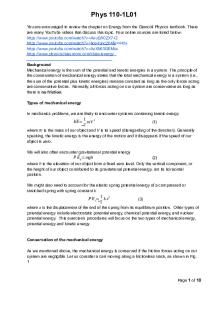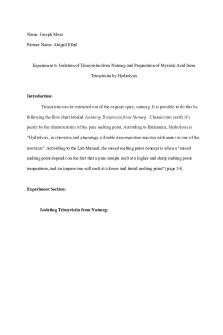Lab 5 final submission Gas Detection Lab Report PDF

| Title | Lab 5 final submission Gas Detection Lab Report |
|---|---|
| Author | Linderson Johns |
| Course | Safety and Health Laboratory |
| Institution | Central Washington University |
| Pages | 4 |
| File Size | 137 KB |
| File Type | |
| Total Downloads | 84 |
| Total Views | 156 |
Summary
Lab 5 - My own work...
Description
Running Head: GAS DETECTION LAB REPORT
GAS DETECTION LAB REPORT Laboratory #4 by
Student Names
Abstract: This laboratory experiment was performed following the guide provided by the instructor and conforming to the OSHA occupational gas regulations identified by the researchers as relevant to this experiment. This lab was conducted with the main aim of teaching the student how to perform gas detection experiments. Additionally, the student learned how to test and calibrate different gas lab equipment. First, pump test was conducted before calibrating the multigap detector using the testing gas. Following the testing and calibration and testing stage was the actual experiment where multi gas detector was used to detect gases. Results were recorded and analyzed accurately. Results showed that the only area with CO is near a car exhaust however researchers believe no person would spend a lot of time near an exhaust pipe therefore they recommend ventilating parking rooms to ensure there is no CO build up.
Introduction: Gas Detection is a very important task that could draw a line between life and death or injury in critical environments where dangerous gases can be formed or released into the atmosphere. Gas detection is important irrespective of whether it is conducted to determine if there is a gas leakage or to comply with occupational health and safety standards. Gas Detection Instrument is a device made up of electrical, optical, mechanical or chemical components that detect and respond to the presence of gas mixtures (Gas Detection Handbook, 2007). This laboratory experiment involved performing gas detection in six different locations within CWU. The MSA Multigas Detector was used to monitor the air in the selected locations. Results were then tabulated in the Gas Detection Form. Recorded data was analyzed and used to perform calculations that help researchers draw conclusions and make recommendations.
Equipment and Materials: The materials and equipment used for this lab were: 1. MSA Multigas Detector. 2. Calibration Testing Gas. 3. Manufacturer’s user’s manuals. 4. Clipboard, pencil, ruler and tape measure. 5. Gas Detection form
GAS DETECTION LAB REPORT Methodology (Procedure): 1. Read the MSA Multigas Detector Manufacturer’s user’s manual to understand directions on how to calibrate and operate it. 2. Perform a bump test, as directed by the manual, using the calibration gas. 3. Calibrate the meter to Zero and perform the full meter calibration with the help of calibration gas. 4. Identify six locations to perform tests: Hogue 142 Elevator, Food Truck, near a car exhaust, mechanical room 117, Hogue 123 Elevator and Near Dean Nicholson Rd. 5. Monitor the air in each of the locations and record the results to the gas detection form. 6. Analyze the results and perform calculations. 7. Report findings and make recommendations. Results/ Findings: Results of data collected from different locations are presented in the Gas Detection Form shown below. Date/Time Started: February 5, 2019 / 2:15 PM Surveyor: Brandon Swaab Meter Manf & Model: MSA Altair 5x Meter S/N: 0042 Performed by: CRN + BS Calibration performed? Yes No Performed by: CRN + BS Bump Test performed? Yes No Performed by: CRN + BS Fresh Air Calibration? Yes No Oxygen (%)
LE L (%)
H2S (PPM )
CO (PPM )
NO2 (PPM )
Hogue 142 Elevator
20.8
0
0
0
0
Food Truck
20.8
0
0
0
0
Near Car Exhaust
19.4
0
2
233
0
Mechanical Room 117
20.8
0
0
0
0
Hogue 123 Elevator
20.8
0
0
0
0
Near Dean Nicholson
20.8
0
0
0
0
Location
Rd.
Time 14:1 6 14:2 0 14:3 8 14.4 2 14:5 0 14:5 3
Conducted by B. S. B. S. M. B. M. B. M. A. M. B.
GAS DETECTION LAB REPORT Calculation: Hypothetical Data: a. 4 hours @ 22 ppm b. 2 hours @ 19 ppm c. 2 hours @ 20 ppm Solution: 8hr TWA= = (t1C1 + t2C2 + … + tnCn)/ 8hr = [(4*22) + (2*19) + (2*20)] / 8 hr = 166/8 = 20.75 ppm Discussion: From the Lab: It is evident that CO is only detectable in close proximity to the Exhaust. According to OSHA, oxygen deficient atmosphere is one that contains less than 19.5 percent oxygen. Near the exhaust, the oxygen level is 19.4 which makes the place oxygen deficient which may lead to asphyxiation of worker. It is important to note that the detectable CO was taken in close proximity to the exhaust pipe in a large outdoor parking lot. There would typically be no reason for anyone to be spending extended period of time near any of the exhaust pipe hence the parking lot would be considered oxygen sufficient. In closed parking lot, it would be important to ensure that there is enough ventilation. From the Hypothetical Data Calculation: The OSHA PEL exposure limit for CO is currently 35ppm this means that from the exposure limit has not been exceeded. Recommendations: Gas Detection Solutions: 1. Wearable gas monitors -These gas detectors are worn to either wrist or strapped to a worker’s body. They are more effective than hand held gas monitors because they are attached to the body, therefore they cannot be easily misplaced. Wearable gas monitors are effective because they measure and alert workers when the gas limits are exceeded. We recommend the MicroRAE wireless multi-gas diffusion monitor. It measures four gases namely: hydrogen sulfide, carbon monoxide, oxygen and combustibles (LEL). It costs $818. 2. We also recommend a fixed Gas detection system to be installed in High risk areas and wired with a warning alarm. We suggest the company install ULTIMA X5000 gas monitor which is known to detects oxygen, and both toxic and combustible gases. It offers calibration frequency options that allows its XCell sensors to detect H2S and CO.
GAS DETECTION LAB REPORT ULTIMA X5000 has longer calibration cycles of up to 18 months. It costs approximately $800, during our lab, there was one worth $750 in eBay. Conclusion: The lab experiment was completed successfully. The students managed to use both the instructions and materials given as well as online research to complete the lab successfully. The students learned how to calibrate a gas detector, obtain readings and compute TWA. Additionally, research revealed important information about installing different Gas testers in an organization. In conclusion, The Lab was a success since we achieved the main objectives of the Lab Experiment.
References: Gas Detection Handbook (2007, August). Key concepts and reference material for permanently installed gas monitoring systems. MSA....
Similar Free PDFs

Gas Laws lab report - Gas laws lab
- 11 Pages

Gas Chromatography lab report
- 5 Pages

LAB REPORT GAS ABSORPTION
- 11 Pages

LAB 5 - Lab report
- 4 Pages

Lab Report 5 - lab
- 5 Pages

Lab 5 - Lab report
- 6 Pages

Template Gas Laws - lab report
- 9 Pages

Micro Lab Report final - lab
- 11 Pages

Lab 5 - Lab experiment report
- 6 Pages

Lab 5 Lab Report- (Microbiology)
- 4 Pages

Final Lab Report - lab work
- 5 Pages

Phys lab 5 - Lab report
- 10 Pages

Gas laws lab final copy
- 10 Pages

Post Lab Report Lab 5
- 5 Pages
Popular Institutions
- Tinajero National High School - Annex
- Politeknik Caltex Riau
- Yokohama City University
- SGT University
- University of Al-Qadisiyah
- Divine Word College of Vigan
- Techniek College Rotterdam
- Universidade de Santiago
- Universiti Teknologi MARA Cawangan Johor Kampus Pasir Gudang
- Poltekkes Kemenkes Yogyakarta
- Baguio City National High School
- Colegio san marcos
- preparatoria uno
- Centro de Bachillerato Tecnológico Industrial y de Servicios No. 107
- Dalian Maritime University
- Quang Trung Secondary School
- Colegio Tecnológico en Informática
- Corporación Regional de Educación Superior
- Grupo CEDVA
- Dar Al Uloom University
- Centro de Estudios Preuniversitarios de la Universidad Nacional de Ingeniería
- 上智大学
- Aakash International School, Nuna Majara
- San Felipe Neri Catholic School
- Kang Chiao International School - New Taipei City
- Misamis Occidental National High School
- Institución Educativa Escuela Normal Juan Ladrilleros
- Kolehiyo ng Pantukan
- Batanes State College
- Instituto Continental
- Sekolah Menengah Kejuruan Kesehatan Kaltara (Tarakan)
- Colegio de La Inmaculada Concepcion - Cebu

